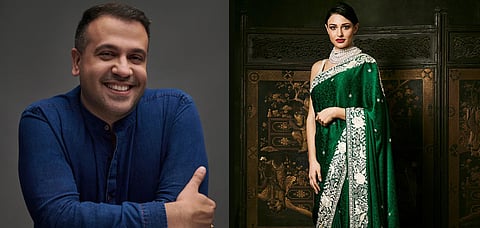Reviving Ancient Weaves With Designer Ashdeen Z Lilaowala
Designer, curator and author Ashdeen Z Lilaowala has been meticulously researching and reviving Parsi Gara embroidery. His stunning designs prominently feature Persian patterns, flowers like poppies and roses and oriental birds like the crane—his signature motif. He launched his eponymous label specialising in hand-embroidered saris in 2012 and now has two stores in Mumbai and Delhi. An NID Ahmedabad graduate, Lilaowala conducted extensive research on Parsi embroidery that took him to China and Iran, and his study of Zoroastrian Kusti weaving was published as a book, "Threads of Continuity—The Zoroastrian Craft of Kusti Weaving. "
What inspired you to revive Parsi Gara embroidery?
The Gara has enamoured me since my childhood. My mother, who always had a keen interest in textiles, has always been my biggest influence. I then honed my interest as a textile design student at NID. After graduating, I worked with the UNESCO Parzor Foundation travelling across India and the world documenting the Gara, and that's really where it all began.
Tell us about your karigars.
The meticulous highly-skilled hand work by our karigars sets the Parsi Gara apart and makes it incredibly precious and worth preserving. India is blessed with world-class embroidery masters who have imbibed this global art form and infused it with their own creativity, finesse and skill. Our accomplished artisans are the key to our success and sustainability.
How is your label ensuring that Parsi Gara is not only revived but has a future legacy?
I started my label with hand-embroidered saris, but now we have extended the application of our traditional techniques to clothing pieces like lehengas, salwar suits, dupattas and stoles, and most recently, accessories like purses and potlis. We are also trying to ensure the legacy through our styling, campaign imagery, photoshoots and collaborations with various style makers and influencers.
How many hours go into making a traditional sari?
Depending on the nature of the work, a Parsi Gara sari can take anywhere from three weeks to two months to execute, with six to eight artisans working on one Gara together.
Do you think there is a trend towards reviving traditional techniques?
There's a renewed interest in traditional textiles and techniques among consumers, and designers like me, who are primarily textile designers and researchers, are more than happy to service this trend. Social media has allowed us to educate and engage customers on our traditional textiles, karigars, and how long something takes and its intrinsic value. I'm thrilled to be living and creating in these exciting times.
What challenges do you continue to face while trying to revive Parsi Gara embroidery?
The biggest challenge was trying to create our vocabulary. It wasn't easy to open people's minds and show them the possibilities of everything the Gara could be. Even today, the odd customer says I always thought Gara was a border sari. It's so much more than that! Earlier in the journey, we were also trying to find our footing as a brand and figure out what works and what doesn't; constantly pushing the boundaries of what was possible. We now better understand how much to push without losing the essence of the Gara.
How did you go about making the embroidery and designs more contemporary?
Our endeavour at ASHDEEN has been to keep the essence of the Parsi Gara embroidery tradition alive while innovating in applications through which we have engaged with younger generations of Parsis and non-Parsi wearers. Specifically, this translates as a stylised application of motifs, a colour palette fine-tuned to suit modern tastes and lighter, more wearable fabrics.
What have you learned about running a label in the last ten years?
I enjoy the challenge of pushing the Parsi Gara tradition in new directions while making sure we stick to the basic framework. This has taken years of research into how the Gara has evolved with the myriad geographical and cultural influences it has imbibed. I find it thrilling to be part of the next frontier of the Gara–incorporating new nuances every season, telling new stories and sparking new conversations.
You frequently design ensembles for weddings and traditional ceremonies. Tell us about that one outfit that stood out.
The custom ASHDEEN sari and blouse intended for my niece Khushnuma's wedding was unique. The sari featured scalloped tulle encrusted with sequins, beads and Swarovski crystals and was done in the traditional Parsi wedding sari style.
After starting with saris, you recently introduced jackets, potlis and stoles. Any reason to diversify?
Seeing our customers experiment with accessories embroidered in the Parsi Gara style is lovely. It's almost like taking away a small piece of the Parsi Gara with you and incorporating it with other Western and Indian clothes.
Quick Takes
What are your designs influenced by?
The rich Parsi Gara heritage
A designer or person who inspires you?
There are many, so I'll stick to saying it's my mother.
A favourite motif?
Our flagship motif—The Crane, which we've even used in our special interiors project.
Favourite colour?
It has to be red. It's vibrant, fearless and glamorous.
A place that constantly inspires you?
Mumbai. Growing up in South Mumbai was a treat to an art, architecture and design enthusiast like myself. I loved walking up and down Marine Drive, Colaba and Fort streets, taking in the architecture of the various iconic Art Deco apartments, public buildings and theatres. They have also played a significant influence in developing my aesthetic.


